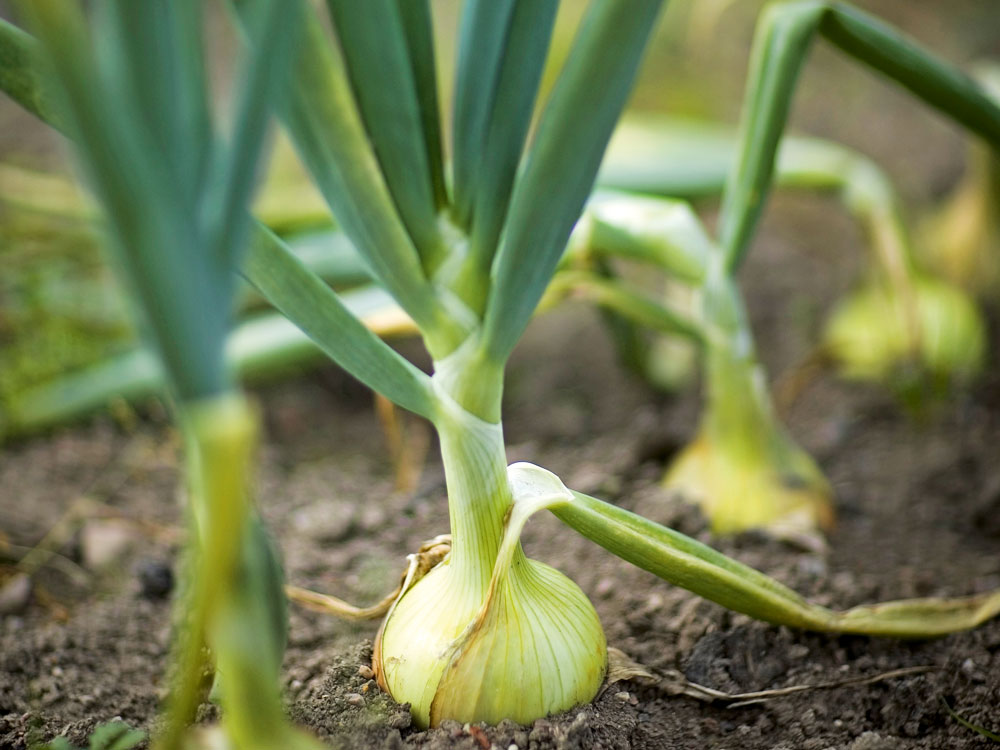How to Grow Onions

Onions are a kitchen staple and despite taking a long time to grow compared to many fast cropping vegies, they are very easy to add to the home harvest.
They need a sunny spot in rich, well-drained soil with a pH of 6.5 to 7 that is not high in nitrogen. A bed that grew tomatoes or zucchini over summer is ideal.
Biennial plants, they grow leaves and bulbs in the first year and usually flower in the second, though they can form flowers early and bolt to seed.
They can take six to eight months to mature, but you can harvest as you grow and properly stored mature onions will last a long time.
Varieties are often described as early, mid or late season, referring to the planting time. Early varieties go in over autumn, mid in early winter and late in late winter and spring. Plant one of each for months of successive crops.
Red, white and brown onions are all available in varieties suitable for different climates, so make sure you choose the right type for you.
Brown onions are best for cooking. White onions have a milder flavour and can be cooked or used raw. Red onions have the sweetest flavour and are the best to eat raw.
All onions are part of the allium family, which also includes leeks, shallots, garlic and chives.
Alliums produce ball-shaped purple, blue or white flowerheads on a long stem. These add a beautiful feature to the garden if you’re keeping the onion for seed, but you should lift mature onions if flower stems start forming, or cut off the flowers.
Growing varieties suited to your area and sowing at the right time will help to prevent onions bolting to seed.
TIP Fence off alliums from pets, as they’re poisonous to dogs and cats.
Choosing a variety
Cream gold
• Mid-season variety
• Full-flavoured flesh
• Excellent keeping onion
• Great for cooler regions
Early Californian red
• Early variety
• Sweet, firm flesh
• Slow to bolt to seed
• Reliable grower for first-timers
Gladalan white
• Mid-season variety
• Stores well
• Can also be grown as a bunching spring onion
In the vegie patch
Rake in a fistful of sulphate of potash per square metre for all soils, adding dolomite for non-alkaline soils.
SOW SEEDS about 5mm deep in rows 300mm apart. Thin seedlings as per the spacing listed on the pack.
WATER REGULARLY at soil level so the onions don’t dry out. As they reach maturity, water only in dry conditions.
Don’t mulch, as onions can rot if covered, and feed every three months with low-nitrogen fertiliser. Weed by hand without disturbing the onions.
HARVEST CROPS as needed once bulbs form or snip the leafy tops for greens at any time. Pull up immature bulbs as spring or green onions for salads.
Dig up onions when the tops die back, leave them in the sun until the outer skins are dry then wipe off any soil, removing the dead tops and roots. Store in a cool, dry place or mesh bag.
Brown onions keep for six months, white onions for three and red for one.
WATCH FOR thrips, tiny insects that feed on new leaves, damaging growth. To prevent infestations, keep the area weed free and water at the roots. Remove onions showing mould or rot.
 Pull up onions when ready to harvest and leave in the sun to dry
Pull up onions when ready to harvest and leave in the sun to dryPlanting onion seedlings
If your previous crop is still in, or the soil is cold or wet, start onions as seedlings. Sow seeds into punnets at the correct time for the variety, leave to grow into strong seedlings, then plant them out into the garden.

Step 1. Sow the seeds
Sow the seeds 5mm deep in punnets of seed-raising mix. Keep just damp in a sunny spot and when big enough to handle, empty the punnets and separate the seedlings. TIP Don’t sow early for the variety or the onion may bolt to seed.

Step 2. Make a trough
Make a shallow trough in the soil of the garden bed. If your seedlings are tall, trim the roots and tops by half. Use a marked-up piece of timber or a knotted rope to ensure the correct spacing between seedlings, usually 50 to 100mm in rows 300mm apart.

Step 3. Position the seedlings
Position the seedlings in the trough, backfilling to bury the roots and not the bulbs. They will stand up in a few days if flat at first. Give them a good watering the first week. TIP Grow with silverbeet, carrots and lettuce but not peas or beans
Vote It Up:

Points: 21

